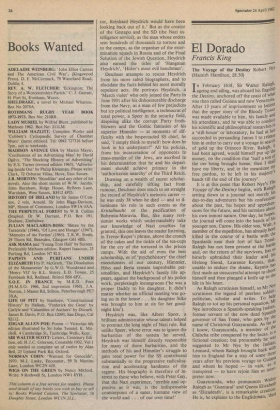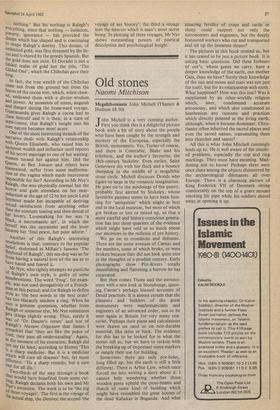El Dorado
Francis King
The Voyage of the Destiny Robert NYC (Hamish Hamilton, £8.50)
In February 1618, Sir Walter Ralegh, ageing and ailing, was aboard his flagship the Destiny, anchored off the coast of what was then called Guiana and now Venezuela. After 13 years of imprisonment so lenient that the upper story of the Bloody Tower was made available to him, his family and his attendants, and he was able to conduct his scientific and philosophical researches In a 'still-house' or laboratory, he had at last succeeded in persuading James I to release him in order to carry out a voyage in search of gold up the Orinoco River. Ralegh, It had been agreed, would himself put uP the, money, on the condition that 'half a ton of the ore being brought home, then I shall have my liberty, and in the meantime al,Y free pardon, to be left in his majestY s hands till the end of the journey'. It is at this point that Robert Nye's The Voyage of the Destiny begins, with Raleg" setting down in a journal not merely his day-to-day adventures but his confessions about the past, his hopes and apprehen- sions for the future, and his surmises about his own inmost nature. One day, he hope!, the journal will come into the hands of his younger son, Carew. His older son, Walt, a member of the expedition, has already,beeil killed in the course of a battle with the Spaniards near their fort of San Torre. Ralegh has not been present at the battle and, on the return of the survivors, has so bitterly upbraided their leader and his lifelong friend, Laurence Keymis, that' unable to endure the shame, Keymis l'``; first made an unsuccessful attempt to OW' himself and then plunged a knife up to the hilt in his heart. As Ralegh scrutinises himself, so Mr 1%!Ye scrutinises the legend of peerless soldier, politician, scholar and writer. To help Ralegh to tot up his personal equation,.n' Nye introduces a Spanish-speaking Inc118.All' former servant of the now dead SPaill- governor of San Tome, who goes . bY name of Christoval Guayacunda. As farn 1 know, Guayacunda, a member of 3 Chibcha tribe conquered by the Incas, is fictional creation; but presumably he was suggested to Mr Nye by the Indian: Leonard, whom Ralegh brought back with him to England for a stay of some three years after his previous voyage to Gulanf' and whom he hoped — in vain, as it transpired — to have rejoin him as inter- preter now. Guayacunda, who pronounces Walter Ralegh as `Guattarar and Queen Elizabeto as `Elizadeath' , is a remarkable creanoui He is, he explains to the Englishman, `dns • • • nothing.' But his nothing is Ralegh's everything, since that nothing — isolation, Poverty, ignorance — has provided the dream which has shaped and is continuing to shape Ralegh's destiny. This dream, of unlimited gold, was first dreamed by the In- cas and is shared by the greedy Spanish. But the gold does not exist. El Dorado is not a fabled realm of gold but the title, 'The
Gilded One', which the Chibchas gave their king.
In fact, the true wealth of the Chibchas came not from the ground but from the leaves of the cocoa tree, which, when chew- ed, endowed them with a divine wisdom and power. At moments of stress, anguish and danger during the homeward voyage, Guayacunda gives Ralegh a cocoa leaf to Chew himself and it is then, in a state of semi-trance, that Ralegh's insight into his own nature becomes most acute.
One of the most interesting strands of the narrative deals with Ralegh's relationship with Queen Elizabeth, who raised him to immense wealth and influence until reports of his secret marriage to one of her waiting- women turned her against him. Did the Queen, as Ben Jonson and others have Maintained, suffer from some malforma- tion of the vagina which made intercourse unPossible for her? According to Mr Nye's ,Ralegh, she was physically normal but the horror and guilt attendant on her near- seduction at the age of 12 by her uncle Lord Seymour made her incapable of deriving sexual satisfaction from anything other than the constant teasing and then denial of her lovers. Lovemaking for her was 'a black, a necromantic art', in which she herself was the sacrament and the lover became_
her 'foul priest, her poor adorer.'
Another of this Ralegh's interesting revelations is that, contrary to the popular ,b,elief, enshrined in Millais's famous 'The Boyhood of Ralegh', this sea-dog was so far from having a natural love of the sea as to have hated and feared it.
Mr Nye, who rightly attempts no pastiche
Ralegh's own style, is guilty of some anachronisms. The word 'Frog', for exam- Pie, was not used derogatively of a French- man at this period; and for Ralegh to define style as 'the best words in the best order' has too blatantly modern a ring. When he ,,uses a genuine quotation, whether from Ralegh or someone else, Mr Nye sometimes gets things slightly wrong. Thus, surely it was of `Dr Donne's verses' and not of Ralegh's Novum Organum that James I remarked that 'they are like the peace of 2°c1; they pass all understanding'. Again, at the moment of his execution, Ralegh did not say (at least, according to Hume) 'This Is a sharp medicine. But it is a medicine which will cure all diseases' but, far more effective, 'Tis a sharp remedy, but a sure urle for all Two-thirds of the way through a book that would have benefited from some cut- ting, Ralegh declares both his own and Mr Nye's intention. The work is to be 'the log 0,,f three voyages'. The first is the voyage of the actual ship, the Destiny; the second 'the
voyage of my history'; the third a voyage into the interior which is man's most secret being. In plotting all three voyages, Mr Nye shows outstanding powers of poetical description and psychological insight.







































 Previous page
Previous page